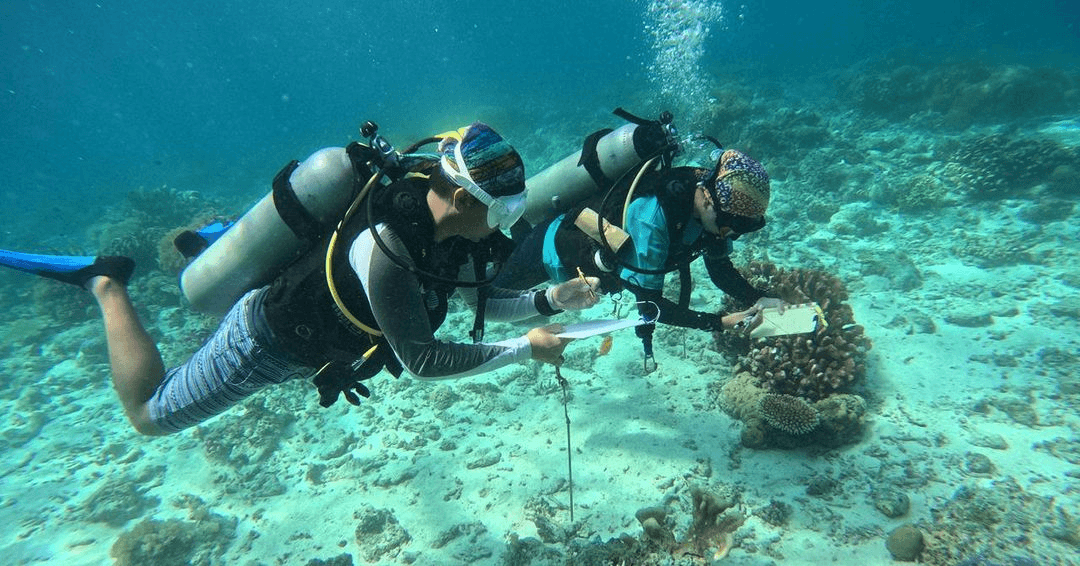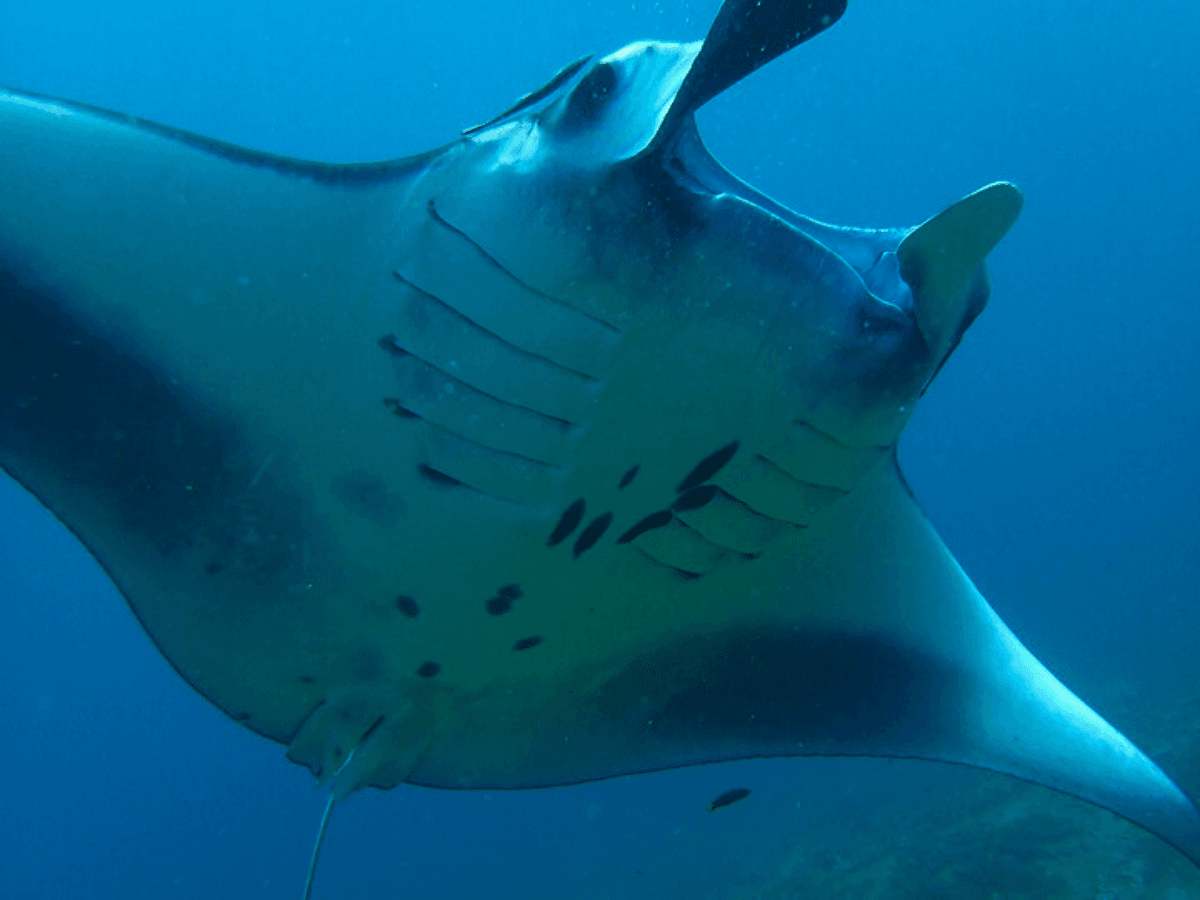Love diving? A divemaster shares her tips on how to take your relationship with the ocean to a deeper level.
Dharkshen Selva discovered scuba diving through her internship with Fuze Ecoteer, a social enterprise focused on conservation. Currently, she is a divemaster with the Tropical Research & Conservation Centre at Pom Pom Islands, Semporna, Sabah.

The coral reef in Pom Pom Islands in Semporna, Sabah showcases its diverse ecosystem.
Photo by Jeethvendra, Tropical Research and Conservation Centre
“The sea, once it casts its spell, holds one in its net of wonder forever.”
– Jacques Cousteau
Much of life’s history began in the ocean, and billions of years later the survival of all living beings on Earth depends on it. We breathe the oxygen it produces, and we have built our lives around the resources it provides.

Illustration of soft-bodied Ediacarans in the ocean, Earth’s first soft-bodied animals. Image by Smithsonian Institution
Home to a quarter of the ocean’s marine life, coral reefs are one of the most productive yet fragile ecosystems in the world. They support an astounding richness of life. The tiniest organism, unapparent to the naked eye such as the phytoplankton, is food to the largest animal in the ocean, a whale shark. There is still so much we do not know about life below water.
Being a fragile ecosystem means that the slightest change in the weather, imbalances in the food chain, or chemical pollution can impact the ecosystem and cause a ripple effect on all parties inhabiting this planet.
As scuba divers, we should be caring for this underwater ecosystem we love to explore, preserving it for the next generation of divers to appreciate. Here is how I slowly deepened my relationship to diving and the communities working towards the ocean’s conservation. Perhaps it can help you on your conscious diving journey, too.
1) Being clear of why I dive
Knowing why I dive makes diving a full body, mind, and soul experience. There are many directions to take your diving journey, having a ‘why’ will influence the path you choose.
Despite growing up on an island in the Andaman Sea, I was not aware of diving until I came across Sylvia Earle. She is a lifelong diver and ocean advocate, spending seven decades exploring the world’s oceans and contributing to marine research and conservation.
Having her as a role model expanded my view on what diving could be – beyond the electrifying sensation of flying through water and seeing creatures I never saw before, it was also a way for me to contribute towards marine conservation. Hence, my diving journey included searching for marine conservation projects in Malaysia to be a part of.
So ask yourself: why do you scuba dive?

Assessing the health of the ecosystem through a transect system. Photo by Perhentian Marine Research Station.
2) Leaving only bubbles behind
The excitement of a dive is real! This can lead to certain behaviour that might cause harm to the ocean and marine life. As with entering any new environment, there are certain guidelines to help us move through it with the least impact.
Some general do’s while you are diving:
- Explore without causing environmental damage. Take care to maintain proper buoyancy to avoid accidentally stepping on corals.
- Document what you see in the ocean as a souvenir, take nothing from it.
- Observe marine life at a safe distance; never feed or chase creatures for a closer look.
- Participate in underwater cleanups; be mindful about throwing anything into the ocean.
It is okay to be curious but it is much better to be aware.

A school of social batfishes in Sipadan Waters. Photo by Jeethvendra, Tropical Research & Conservation Centre.
3) Choosing an environmentally conscious dive centre
Information is a click away. Ask the tough questions and the corals will be thankful.
- How does the dive company care for the dive sites they explore frequently?
- Do they educate guests about the local environment and marine life?
- How do they engage with and support marine conservation projects?
- What steps do they take to minimise their impact on the local ecosystem?
Remember, they do not have to be perfect, but they can always strive to do better.
A quick way to look for centres with responsible practices is by checking out Green Fins. It is an initiative that protects and conserves coral reefs through environmental guidelines, promoting a sustainable diving and snorkelling industry.
To be a Green Fins member is to follow the Green Fins Code of Conduct. Members receive annual assessments, training, and feedback to help them improve their environmental sustainability. Ideally, it is best to support operators who hold national or international eco-certification.

Yearly assessments are done to evaluate dive centres’ environmental impact.
Photo by Green Fins
Some dive operators can be ocean advocates but do not have the means to pay for a Green Fins annual membership fee. If you would like to support these smaller businesses, you can still do so after some thorough research across digital platforms and asking your avid scuba friends for recommendations.
As a frequent diver in the Perhentian Islands, Sea Voice Divers (Coral Bay), Panorama Divers (Long Beach), and Cosmic Dive Centre (Pulau Besar) are my go-to choices for their values, hospitality, and great vibes.
4) Becoming a citizen scientist
Studies based on accurate data play a crucial role in bridging the gaps between policy, regulation, and the protection of our ecosystems. Marine scientists around the world require quality data to advance critical marine research. They need you!

Preparing coral ‘biscuits’ which are small fragments of coral planted on a cement brick to be placed on an existing artificial reef underwater.
Photo by Jeethvendra, Tropical Research and Conservation Centre.
Your love for diving and the ocean can be put to good use via conservation volunteering. Besides collecting data, volunteers can help with other crucial activities like checking water quality, participating in underwater cleanups, identifying key species, physical monitoring of coral reefs and marine life, building community awareness, replanting healthy coral fragments onto damaged or bleached reefs, and maintaining coral nurseries.
There are several marine conservation projects in Malaysia that require assistance from qualified divers. Perhentian Marine Research Station (PMRS) and Tropical Research & Conservation Project (TRACC) are projects that offer scuba divers conservation-related activities that can potentially interest you. Reef Check Malaysia offers an EcoDiver course that trains certified scuba divers how to survey marine environments. It is a great way to give back to the reef while picking up a new certification.

Certifying the local youths of Larapan Island as Reef Check EcoDivers. Photo by Reef Check Malaysia
Not ready to join a programme but would still like to contribute to science during leisure dives? You may want to consider submitting your underwater shots of marine animals for research.
Photo-ID databases help researchers estimate population sizes of animals and document their movements seasonally and spatially. With enough information, this reveals their migration patterns and where they feed and reproduce, allowing for better conservation.
Documentation, however, should be done in the most non-invasive way possible, as these creatures are sensitive to disturbances. There are helpful guidelines online to help you swim with these creatures responsibly. Once you have familiarised yourself with the best practices, all you need is a camera, a little practice capturing underwater shots, and you are ready to contribute to turtle and manta identification.
We identify a turtle by its facial scale; it is unique to each turtle and stays the same over time. Once you have the images, you can then log your identification photos with a global database such as Internet of Turtles.
If you want to photo ID a turtle, remember to take photos of:
- The left cheek
- The right cheek
- A bird’s-eye view of the shell

An intern photographing a turtle to upload to Internet of Turtles. Photo by Rinaldi Gotama, Indo Ocean Project.
Manta rays possess a set of markings and colour patterns on its underbelly that is unique to the individual ray. By photographing their ventral surfaces and uploading them on IDtheManta or Manta Matcher, your images would enable scientists to identify mantas for global research and conservation efforts.

Captured here is a ventral surface shot of a Reef Manta Ray (Mobula alfredi) ideal to
upload onto the citizen science database. Photo by Rinaldi Gotama.
5) Volunteering my skills
I was fortunate to be able to progress in my diving journey when I discovered an opportunity to provide communications support for a marine conservation project in exchange for a divemaster scholarship!
If you have useful skills that may benefit dive centres or marine conservation projects, start a conversation with them. Skills such as marketing, communications, finance, project management, cooking, and many others are often sought after.
Get in touch and you might land yourself a short term opportunity to volunteer your skills in exchange for dives, qualifications, or even better, a scholarship.
 Travellers Alice and Tino enjoying their volunteering month at the Perhentian Island with Cosmic Divers. Photo by bike4oceans
Travellers Alice and Tino enjoying their volunteering month at the Perhentian Island with Cosmic Divers. Photo by bike4oceans

Volunteers from all around the world contributing to the ocean and raising awareness in the Perhentian Islands. Photo by Fuze Ecoteer.
Forming and maintaining a healthy relationship with nature is an individual journey. Once you make a start, it becomes easier to navigate the journey of being environmentally conscious on land and underwater.
Read more from Dharkshen: Ways to Tour the Mangroves Consciously
Writer: Dharkshen Selva (Tropical Research & Conservation Centre)

